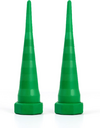I've seen videos on YouTube in which its claimed that if you turn off both radiator valves then open the bleed screw ( and close it again) you can create a vacuum in the rad that enables you to work on valve-to-rad connections without draining, or losing much water. Does that actually work in practice? I've always drained all the water out of a rad before making or remaking joints.
You are using an out of date browser. It may not display this or other websites correctly.
You should upgrade or use an alternative browser.
You should upgrade or use an alternative browser.
Can you work on valve-to-rad connections without draining?
- Thread starter amfisted
- Start date
Sponsored Links
So long as the valves, including the trv, do turn off fully. I use a rubble sack (with no holes in) to catch any water - you can place it underneath and around the valve to rad connection. Depending on how long the job will take, you could open the bleed screw to allow the rad to fuu'y drain into the bag.
I regularly fit new tails to full rads. You're always going to lose some water so sheeting up and drip trays are essential. Actually, once the rad spanner is inserted on union type tails, hardly any water escapes. Have the new tail ready taped up and switch over quickly. If its a compression tail going in, I put a compression stopend just nipped up on it. Probably lose less than a teacup of water.
Sponsored Links
Much obliged for that info, thanks. I have a weeping rad-nut-to-valve connection that I need to tackle.I regularly fit new tails to full rads. You're always going to lose some water so sheeting up and drip trays are essential. Actually, once the rad spanner is inserted on union type tails, hardly any water escapes. Have the new tail ready taped up and switch over quickly. If it’s a compression tail going in, I put a compression stopend just nipped up on it. Probably lose less than a teacup of water.
Compression or union?I have a weeping rad-nut-to-valve connection that I need to tackle.
If compression, ease the joint apart and put a couple of turns of PTFE round the olive.
If union, a smear of jointing compound on the tapered mating surface.
It’s compression, and the joint is actually dry at the moment after weeping slightly for a day or two following a rad swap. So I’ll just monitor for now, but definitely put your advice to good use if it leaks again.Compression or union?
If compression, ease the joint apart and put a couple of turns of PTFE round the olive.
If union, a smear of jointing compound on the tapered mating surface.
Blimey, never seen those before. Some sort of temporary stopper?
I changed a a rad for a heated towel rail for someone today, had to alter pipework slightly to make it neat.
Used the bungs as shown above, lost about a litre of water before it sealed, job done.
Used the bungs as shown above, lost about a litre of water before it sealed, job done.
Well, as is no doubt obvious from my enquiries I’m a DIYer and not a professional, but they certainly strike me as something I ought to keep in my toolbox.I changed a a rad for a heated towel rail for someone today, had to alter pipework slightly to make it neat.
Used the bungs as shown above, lost about a litre of water before it sealed, job done.
Doing it day in day out gives you the confidence to know what should work and that the trickle of water is not going to turn into a torrent. Any pro will also be able to tell you tales of when things have gone wrong. You laugh about them later but not funny at the time. I usually have a wet vac plugged in within reach just in case and a pocket full of caps, stopends and bungs to cover any eventuality.
yes - exactly that. made of silicone so they can be jammed in and they stick. I use them for rads and for bunging Cold Water Cistern feeds and any other gravity system pipework. Got me out of plenty of tricky spots before now.Blimey, never seen those before. Some sort of temporary stopper?
Everyone thinks when they take off rads valves that the rads is going to empty all over the floor in secs, as long as the bleed screw is in and everything is tight then as suggested, the water in the rads will only slowly glug out, so plenty of time to get a bung in and only lose half a cup full if that.
Thanks for that. I might even put them on my early Christmas list!yes - exactly that. made of silicone so they can be jammed in and they stick. I use them for rads and for bunging Cold Water Cistern feeds and any other gravity system pipework. Got me out of plenty of tricky spots before now.
DIYnot Local
Staff member
If you need to find a tradesperson to get your job done, please try our local search below, or if you are doing it yourself you can find suppliers local to you.
Select the supplier or trade you require, enter your location to begin your search.
Please select a service and enter a location to continue...
Are you a trade or supplier? You can create your listing free at DIYnot Local
Sponsored Links
Similar threads
- Replies
- 32
- Views
- 28K
N
- Replies
- 5
- Views
- 6K
- Replies
- 5
- Views
- 7K
- Replies
- 3
- Views
- 626
- Replies
- 5
- Views
- 7K
D


